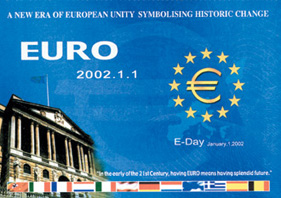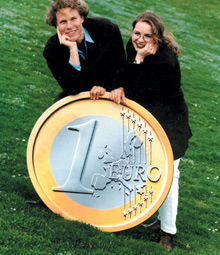
Authough the long-awaited debut of Euro banknotes and coins on Tuesday was largely considered a technical step and of limited macroeconomic significance, it signalsthe coming of age of a currency that is destined to revise the world monetary landscape and bestow a significant and profound impact on the economic growth of China
Impact on China's finance
The newborn Euro has substantial financial implications for China's foreign exchange reserves, foreign debt, monetary policy and the banking sector. First of all, it presents a fresh option for China to diversify its foreign exchange reserves, which reached US billion in mid-October.
Secondly, it also provides a stage for China to restructure its foreign debt by borrowing more Euro-denominated debt and cutting its yen liabilities. The Japanese yen takes up a relatively high proportion of China's outstanding foreign debt, putting China at a tremendous foreign debt risk.
Experts expect that the creation of the Euro will water down the pressure put onthe RMB from fluctuations of the US dollar and Japanese yen, which will be a long-term stabilizing factor for RMB. The power of the dollar and yen are in doubt as both economies are doing badly.
On the other hand, the currency unification will push European banks towards theuniversal banking model, typical in Germany, making them more competitive and consequently putting more pressure on Chinese banks. Monetary unification has already taken a considerable chunk of profits away from Chinese banks, as conversions between the 12 legacy currencies are no longer needed, while European banks have already enjoy a cozy position in the world banking system, taking up more than 300 seats among the world top 1,000 banks.
Chinese banks should put more stress on Frankfurt,swheresthe European Central Bank is headquartered, in their overseas business strategies, alongside their long-time emphasis on London.
Impact on Chinese companies' business
The launch of the Euro also has far-reaching effects on China's foreign trade and use of foreign direct investment, experts said.
The adoption of the single currency Euro demonstrates closer co-operation in theregion and presents challenges for Chinese companies in the short term. But the Euro is expected to boost the EU economy, which is conducive to Chinese companies' business with EU firms. The EU now imports about half of its energy and two-thirds of its materials from other countries, and a thriving EU economy is expected to boost demand and increase imports.
Simplify procedures
The new currency will also simplify procedures for Chinese companies exporting to the EU.
With the launch of the Euro, the EU reduces its internal trade barriers and replaces the complicated import management systems of the 12 EU countries with unified rules, saving Chinese companies time and money.
The emergence of a single currency in the region also simplifies Chinese companies' settlement of trade with EU companies and cuts down their inflation proof costs.
Increase EU's investments in China
The EU's investments in China are also expected to increase following the launchof the Euro. A strong Euro will prompt EU companies to turn to long-term investment plans and invest large amounts in transportation, energy, materials manufacturing and agriculture,swheresChina especially welcomes foreign investors to enter.

Disadvantages
But the enhanced co-operation among EU countries favors member economies and disfavors non-members Trade between EU countries increased seven-fold over the last two decades, compared with a rise of just 2.5 times in trade with other countries, according to EU statistics.
Trade within EU countries now makes up 60 per cent of their total foreign trade.
The adoption of the Euro eliminates foreign exchange risks within the EU, reduces transaction costs, facilitates the flow of commodities, labor and capital and is helpful for EU countries at different economic development levels to re-allocate their labor and resources.
Eager to expand to the east, the EU is expected to favor trade with and investments in Central and Eastern Europe, which could place pressure on China's advantage in labor-intensive products.
The majority of Chinese exporters to the EU are small and medium-sized enterprises and the cost of adjusting their financial documents, upgrading technological equipment and training personnel weighs heavily on them.
It is better that the government educates domestic companies, publicizes information about the Euro and helps them train their financial personnel to lay down new financial strategies.
Domestic companies should adjust their marketing strategies in accordance with the use of a new single currency in the region. The old way of price differentiation for individual EU markets should be given up. In the face of increasing anti-dumping charges by EU firms, Chinese exporters should avoid price competition and reduce these unfavorable factors for market exploration due to bad internal co-ordination. Chinese companies must improve the product structure of their exports to the Euro region.
Statistics of I/E between China and European Countries from Jan to Sep of 2001
| |
| Country(Region) |
I/E |
export |
import |
| Europe |
7,222,813 |
3,617,674 |
3,605,139 |
| Belgium |
314,903 |
186,204 |
128,699 |
| Denmark |
118,846 |
72,331 |
46,515 |
| Britain |
758,045 |
493,020 |
265,026 |
| Germany |
1,713,456 |
701,586 |
1,011,870 |
| France |
586,618 |
276,810 |
309,808 |
| Ireland |
77,382 |
36,376 |
41,007 |
| Italy |
596,540 |
307,482 |
289,058 |
| Luxemburg |
7,393 |
2,924 |
4,469 |
| Holland |
640,351 |
532,336 |
108,015 |
| Greece |
53,811 |
50,230 |
3,581 |
| Portugal |
25,221 |
20,172 |
5,049 |
| Spain |
221,888 |
169,500 |
52,388 |
| Austria |
76,617 |
26,892 |
49,726 |
| Finland |
250,932 |
61,643 |
189,289 |
| Sweden |
243,087 |
73,502 |
169,585 |
| Albania |
1,150 |
1,150 |
0 |
| Bulgaria |
8,423 |
6,728 |
1,695 |
| Hungary |
88,301 |
78,121 |
10,179 |
| Iceland |
3,428 |
2,189 |
1,239 |
| Monaco |
278 |
155 |
123 |
| Norway |
74,954 |
32,106 |
42,848 |
| Poland |
91,102 |
77,577 |
13,525 |
| Romania |
27,151 |
18,938 |
8,212 |
| Switzerland |
176,500 |
51,013 |
125,487 |
| Estonia |
24,611 |
23,666 |
944 |
| Latvia |
4,039 |
3,580 |
459 |
| Armenia |
296 |
196 |
100 |
| Belarus |
3,736 |
738 |
2,999 |
| Kazakstan |
97,453 |
24,234 |
73,219 |
| Kirghizstan |
9,094 |
5,716 |
3,379 |
| Russia |
759,303 |
178,274 |
581,029 |
| Turkmenistan |
2,921 |
2,821 |
100 |
| Ukraine |
65,250 |
17,715 |
47,536 |
| Yugoslavia |
7,523 |
6,613 |
910 |
| Slovenia |
6,354 |
5,550 |
803 |
| Croatia |
11,832 |
11,391 |
441 |
| Unit:ten thousand USD |
|
![]() 本网站由北京信息港提供网络支持
本网站由北京信息港提供网络支持

